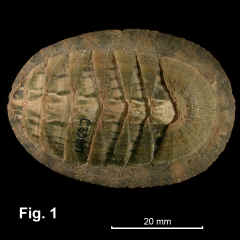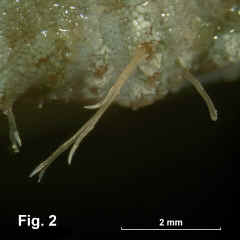|
|
LORICIDAE |
|
|
|
Loricella angasi (H. Adams, 1864) Description: Shell broadly ovate, girdle broad anteriorly, narrowing towards posterior, head valve unusually large. Median valves with pleural and lateral areas well defined; lateral areas raised, with variable number of irregularly nodulose radial ribs, pleural area with coarse longitudinal ridges. Girdle partly slit posteriorly; covered with very fine scales and irregularly spaced, branched corneous processes (Fig. 2). Colour dull brown or grey, sometimes with darker longitudinal streaks; shell usually covered with marine growth. Size: Up to 83 mm in length. Distribution: Endemic to Australia: southern Qld southwards to SA, including Tas. Habitat: This species lives in the low intertidal and shallow subtidal, under stones. Moderately common. It was reported by Ludbrook & Gowlett-Holmes (1989, p. 520) that this species is carnivorous, feeding mainly on amphipods, in a similar way to the North American Placiphorella velata. They reported "In these chitons [meaning Placiphorella velata] an enlarged girdle flap surrounds the head. This is raised above the substrata and clamps down rapidly an any amphipod seeking shelter beneath it". I have not been able to locate any further Australian reports to substantiate this claim for the Australian species. Synonymy: Loricella torri Ashby, 1919 is a previously recognised synonym. Remarks: The girdle contains corneous "processes", appearing like minute branched trees, as shown in Fig. 2. Fig. 1: Port Arthur, Tas. (C.039867). Fig. 2: Girdle scales and corneous processes. Locality: Satellite Island, off Bruni Island, Tas. (C.563221). |
|

